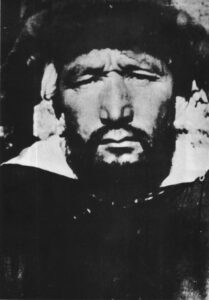Osman (1899-April 1951), was a Kirei Kazakh military leader. He was executed in 1951 for opposing the Chinese Communists.
A Kazakh of the Kirei tribe, Osman was born in an encampment in the Altai region of northeast Sinkiang. The Kazakhs of Sinkiang were nomadic herdsmen, and Osman received his basic Islamic education in various encampments. He was introduced to warfare at the age of 12, when Boko Bator, a blood brother of Osman's father, took him along on an anti-Chinese campaign. With the failure of this uprising, Osman returned to his father's encampment. Much of his later education was devoted to riding, fighting, and learning to drink kumis; and he developed into a vigorous fighting man, noted for his large size and great strength. Osman won fame among the Sinkiang Kazakhs during the administration of Sheng Shih-ts'ai (q.v.) in Sinkiang. Between 1937 and 1940 Sheng antagonized the Kazakhs by arresting many of their leaders and executing some of them. In 1940 Osman worked to mobilize resistance to Sheng's oppressive rule, but he and his rebel band were not strong enough to overcome the Chinese authorities. By the winter of 1942 Osman's small force, which had been driven out of Sharasume (Ch'enghua) had withdrawn to the upper reaches of the Bulgan River, on the Sinkiang-Mongolian border. Osman established his headquarters at Tayingkul, just inside the border of Outer Mongolia. He worked to foster Kazakh-Mongol cooperation, and he secured some arms and equipment from the Mongols. Before long, he had formulated a political program that called for Kazakh autonomy in the Altai region and for the barring of Chinese military and civilian officials from that region. Sheng Shih-ts'ai, meanwhile, strove to suppress Kazakh resistance through military action, including the use of aerial bombing, to destroy the Kazakhs, their yurts, and their livestock. Sheng asserted publicly that Osman was receiving Soviet aid and direction, and that Sinkiang would know neither prosperity nor peace until the Kazakhs were suppressed.
The Kazakh movement in Sinkiang gained support in November 1944, when the open revolt against Chinese rule broke out in the Ili district of northwest Sinkiang. Osman apparently concluded an agreement with the Ili military leader Ali Khan Türe, and his Kazakh cavalrymen took advantage of Chinese preoccupation with the Ili revolt to capture Sharasume and Chugachak (T'ach'eng), leading towns in the Altai district. With the establishment of the so-called East Turkestan Republic at the beginning of 1945, Osman received the post of special executive officer for the Altai district, with headquarters at Sharasume. In November 1945 he severed relations with the Mongols of Outer Mongolia even though he was beginning to have difficulties with the Ili rebels. In January 1946 Chang Chih-chung (q.v.) succeeded in working out an agreement that called for a coalition government in Sinkiang in which the non-Chinese nationalities of the province would gain representation. The Naiman Kazakh tribes continued to support the Ili group after this agreement was signed, but the Kirei Kazakhs, whom Osman represented, soon became restive. In April 1946 Osman, acting in the name of his Kazakh followers, denounced the Ili regime as Russian-dominated, struck camp, and marched into the mountains on the Sinkiang-Mongolian border. Later that year, after receiving a representative of Sung Hsi-lien (q.v.), the Chinese Nationalist military commander in Sinkiang, Osman came to terms with the Chinese authorities, his erstwhile enemies. He and his men clashed that summer and autumn with the Ili forces in the remote Baitak Bogdo (Peitashan) district. By 1948 Osman had demonstrated firm opposition to the Ili regime, the Mongolian People's Republic, and the Soviet Union. His continued support of the Chinese in Sinkiang won him command of three Paoan squadrons as a reward. In 1948 Osman's headquarters were located in the T'ienshan range, where he claimed power over 4,000 yurts and 15,000 Kazakhs. In the autumn of 1948 such American and British correspondents as A. Doak Barnett, Henry R. Lieberman, and Ian Morrison visited Osman at his T'ienshan encampment.
Osman took to the field again in 1949 when T'ao Chih-yueh, who had replaced Sung Hsi-lien as the top Nationalist commander in Sinkiang, switched allegiance to the Chinese Communists. After moving his forces toward Hami, Osman joined with Yolbars (q.v.) in organizing anti-Communist resistance. By September 1950, Osman had been forced to withdraw to a new base in the Gezkul district of Tsinghai. About this time, Yolbars decided that it was useless for the Kazakhs to attempt to maintain themselves against Chinese Communist power. He and many of his followers departed for India on the first leg of their journey to Taiwan. Osman, however, decided to remain behind. In February 1951 Chinese Communist military units, operating from bases in Hami and Urumchi, attacked the remnant Kazakh forces in their Gezkul encampment and captured Osman, one of his daughters, and some of his followers. Osman was taken to Urumchi, where he was executed as a counter-revolutionary in April 1951.

乌斯曼
乌斯曼(1899—1951.4),哈萨克族的军事首领,因反对中国共产党于1951年被处决。
乌斯曼是吉雷部落人,出生在新疆东北阿尔泰地区的牧人帐篷中。新疆的哈萨克人是游牧民族,乌斯曼在牧人的帐篷中接受伊斯兰基本教育。十二岁时随从他的叔父博科·巴托尔抗击汉族时开始接触军事。此次起事失败后,乌斯曼回到他父亲的处所,此后他的大部分教育内容都是学习骑射,饮马奶酒,而成长为一个好争斗的人,他以体魄高大强壮有力知名。
盛世才统治新疆时,乌斯曼在哈萨克部族中出了名。1937—1940年间,盛世才敌视哈萨克族人,逮捕其首脑人物多人,有些并被处死。1940年,乌斯曼动员族人起而反对盛世才的压迫,但其所部反叛势力还不足以推翻中国当局。1942年冬,乌斯曼的小小部队,被逐出承化,退到新蒙边境布尔根河上游,在外蒙古边境内的塔音库尔设立指挥所。他力求建立哈蒙合作。他从蒙古取得了一些军火和装备。不久,他拟定了在阿尔泰地区实施哈萨克自治和驱逐该地汉族军政官员的政治方案。此时,盛世才力图以武力镇压哈萨克人的反抗,包括用空军轰炸,消灭哈萨克人及其帐篷牲口。盛世才公开宣称,乌斯曼取得了苏联的帮助和指导,哈萨克人如不被镇服则新疆无繁荣与和平可言。
新疆哈萨克的活动,于1944年11月得到了支援,那时新疆西北伊犁地区发生反对汉族的骚乱。乌斯曼显然和伊犁军事首领阿里•汗•图雷订立协定,并趁汉族忙于对付伊犁骚乱之机,攻占了承化、塔城这两个阿尔泰地区的首要城市。1945年初东土耳其斯坦共和国成立,乌斯曼任阿尔泰地区特别执行官,驻守承化。11月,他与外蒙古断绝关系,尽管那时他已与伊犁的叛乱分子开始有了纠纷。
1946年1月,张治中搞成了一个协定,在新疆成立有非汉族代表参加的联合政府。但是协议签订后,那伊曼哈萨克部落仍支持伊犁集团,而乌斯曼为代表的基雷哈萨克族叛乱不久平息下来。1946年4月,乌斯曼以哈萨克同伙的名义,否认伊犁当局,斥责它是俄国操纵的,袭击其军营并向新蒙边境的山地进军。同年年底,乌斯曼接见了国民政府驻新疆军事司令宋希濂的代表,与先前的敌人汉族当局签订了协议。是年夏秋之间,他与部下同远处白塔山地区的伊犁部队发生冲突。1948年,乌斯曼表示强烈反对伊犁当局、蒙古人民共和国及苏联。他对在新疆的汉人的继续支持使他获得这样的报酬:受任指挥三个保安骑兵中队。1948年,乌斯曼在天山建立指挥部,统率四千家帐篷,一万五千名哈萨克族人。1948年秋,美英两国记者如巴尼特、李普曼、莫里森,曾在天山指挥部访问过乌斯曼。
1949年,代宋希濂任新疆省国民党军事司令的陶峙岳转而效忠中国共产党,乌斯曼又重上战场。他率部向哈密进军,联络尧乐博士组织反共抵抗活动。1950年9月,乌斯曼被迫撤退到青海地区的一个新的基地。此时,尧乐博士认定哈萨克人企图保存自己反对中国共产党政权已无可能,乃携同部属先到印度以便前往台湾,乌斯曼决定仍留在那里。1951年2月,中国共产党部队从哈密、乌鲁木齐进袭格兹库尔营地的哈萨克残部,俘获乌斯曼及其一个女儿和一些随从。乌斯曼被押送到乌鲁木齐,1951年4月被作为反革命分子处死。